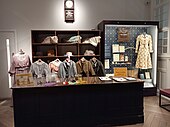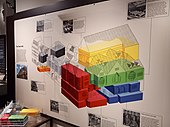The Museum of Oxford (MOX) is a history museum in Oxford, England, covering the history of Oxford and its people.[1] The museum includes both permanent and temporary displays featuring artefacts relating to Oxford's history from prehistoric times to the present day. The museum also acts as a public meeting space which people and organisations rent for both public and private events. Other activities facilitated by the museum include frequent public talks by historians and local cultural organisations,[2] organised school tours, family activities, adult learning workshops, and an older people's program.[3]
 | |
| Established | 1975 |
|---|---|
| Location | St Aldate's. Oxford, England, OX1 1DZ |
| Type | Local history museum, archaeology, & social history |
| Collection size | 750 exhibits |
| Architect | Museum housed inside building designed by Henry Hare in the Jacobethan style |
| Owner | Museum of Oxford Development Trust Registered Charity No. 1173867 |
| Website | museumofoxford |
The museum contains a gift shop stocked with items related to Oxford's history and cultural heritage, including books, toys, food, clothing, postcards.
The museum is situated in Oxford city centre, located inside Oxford Town Hall on St Aldate's Street.
History of the museum
The Museum of Oxford was first opened in 1975 inside Oxford Town Hall, occupying the former premises of the Oxford Public Library.[1] The museum is situated inside Oxford Town Hall, which was first opened in 1897 and was built by the architect Henry Hare in the Jacobethan style.[citation needed]
In 2005 the museum was awarded a financial grant by the Big Lottery funding scheme, Home Front Recall. This project aimed to collect and preserve memories of the Second World War from residents in Oxfordshire to commemorate the 60th anniversary of the war's end.[4]
In 2009 Oxford City Council considered closing the Museum of Oxford to save money, as the upkeep of the museum was costing £200,000 annually. However the closure of the museum was opposed by the Oxford Civic Society, who campaigned for its continuation and helped the museum organise a rota of volunteers to keep the museum running on a reduced cost.[5]
In 2018 the museum acted as a temporary home to archaeological artifacts uncovered during the construction of Oxford's Westgate Shopping Centre.[6][7]

Refurbishment – 2018–2021
From July 2018 to October 2021 the museum closed for a refurbishment which tripled the size of the museum space.[8] The estimated cost of the refurbishment was 3.2 million,[9] but was completed with a budget of 2.8 million by the architectural firm Purcell,[10][11] and was funded by Arts Council England, the National Lottery Heritage Fund, and Oxford City Council.[12] The refurbishment raised the number of exhibits from 286 to around 750.[13][14] In 2020 Oxford City Council leader Susan Brown suggested that Oriel College's infamous statue of Cecil Rhodes could be relocated to the Museum of Oxford.[15] [16] During this time which encompassed the COVID-19 pandemic, the museum begun focusing more heavily on online material and temporary displays were erected in other rooms also located inside Oxford Town Hall.[citation needed]
Expansion – 2021–present
Since the 2021 October reopening the museum has relied upon a large network of over 100 volunteers.[17] The museum also begun hosting a series of workshops for school children to teach them about local history.[18] Also in 2021 the museum won a National Lottery grant of £240,000 for its Hidden Histories project.[19]

In 2022 the museum hosted a Digital Artist in Residence to create digital artworks featuring Oxfordshire's folklore and legends.[20] The end result was an interactive videogame exploring pre-Christian British mythology.[21]
In 2023, the Museum of Oxford became the first venue in Oxford city center to host a performance of Little Edens, a theatrical production based on Oxford's Florence Park Rent Strikes in 1934.[22][23]
Themes
The Museum of Oxford focuses solely on the history and culture of the City of Oxford, with a focus on the people of the city who are residents rather than the University of Oxford. Such themes included within the displays include football, women's rights, policing, entertainment, engineering, social history, Jewish and Christian history, archaeology, and British military history.[citation needed]
In recent years there has been a shift towards creating more displays featuring Black British history and LGBTIQA+ history.[24][25] In 2021 following the refurbishments the Museum of Oxford had unveiled a temporary Windrush display celebrating the history of Caribbean people in Oxford since the 1950s.[26]
Key exhibits

Some of the museum's most notable items and exhibits include:
- Oliver Cromwell's death mask
- Artefacts from Oxford's Jewish quarter
- Oxford's city crest, gifted by Elizabeth I
- A chunk of the infamous Cutteslowe Wall[27]
- Cold War artefacts for measuring nuclear fallout[28]
- Tickets from The Rolling Stones concert in Oxford[29]
- A copy of Pink Newspaper, Oxford's first LGBT newspaper[30]
- Personal possessions of Lewis Carroll, author of Alice's Adventures in Wonderland[28]
- Personal possessions of Alice Liddell, the inspiration for Alice of Alice's Adventures in Wonderland[31]
- A tin of Frank Coopers Marmalade which was taken on Robert Falcon Scott's ill-fated journey to the South Pole [28]
Temporary and online exhibits
Alongside permanent displays, the Museum of Oxford has hosted a number of temporary exhibits. Past examples have included Of Ordinary Things featuring art by Iraqi women living in Oxford,[32] and Queering Spires which won the National Lottery's 'Sustainable Project of the Year Award'.[24][33] [34]
One of the most common activities facilitated by the museum are memory collecting events where local people are encouraged to visit the museum to share items, photographs, and memories of their lives in Oxford. One such event was the Sporting Oxford Collecting Day in 2019 which encouraged residents to share memories of sports in Oxford.[35] The museum also hosts occasional online displays, one of which was a project called City Stories in 2022 which sought to collect and preserve oral histories and photographs from the city's residents.[36]
The museum also hosts temporary events parallel to wider Oxford celebrations, such as facilitating an arts and crafts workshop called Queenly Crafts as a part of Oxford's annual Alice Day celebrations.[37]
Gallery
- MOX entrance (inside town hall)
- View of MOX main gallery from gift shop
- View of MOX main hall from seating area
- An interactive exhibit for trying on historic clothes
- Map of Oxford Town Hall
- A performance of the historical drama Little Edens is performed in the Museum Makers Space
- A Historical reenactment in the Museum of Oxford depicting activist Abraham Lazarus during the 1934 Florence Park rent strike
Accessibility
Every room within the Museum of Oxford is wheelchair accessible. This includes a lift to access both galleries and areas which are not ordinarily open to the public.[38] However the steps in front of the main entrance to Oxford city hall are not wheelchair accessible, and disabled visitors will need to enter via an alternative entrance. Most display cases are designed so that they can be viewed from wheelchair height.[38]
Admission to the museum is free and the galleries are open every day except Sundays and holidays.[39]
Rented spaces
The basement areas of the Museum of Oxford hold two meeting halls which the museum rents for both public and private events. The largest room is called the Museum Makers Space, the smallest is called the Learning Studio.[30] Also available is a kitchenette, museum props, Wi-Fi, furniture, baby changing areas, gender neutral toilets, and on-site catering.[39]







